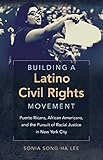Building a Latino civil rights movement : Puerto Ricans, African Americans, and the pursuit of racial justice in New York City / Sonia Song-Ha Lee.
Material type: TextLanguage: English Series: Justice, power, and politics | Justice, power, and politicsPublisher: Chapel Hill : The University of North Carolina Press, [2014]Description: xi, 332 pages : illustrations, maps ; 25 cmISBN:
TextLanguage: English Series: Justice, power, and politics | Justice, power, and politicsPublisher: Chapel Hill : The University of North Carolina Press, [2014]Description: xi, 332 pages : illustrations, maps ; 25 cmISBN: - 9781469614137 (cloth : alk. paper)
- Puerto Ricans -- Civil rights -- New York (State) -- New York -- History -- 20th century
- Puerto Ricans -- New York (State) -- New York -- Politics and government -- 20th century
- Puerto Ricans -- New York (State) -- New York -- Social conditions -- 20th century
- African Americans -- Civil rights -- New York (State) -- New York -- History -- 20th century
- African Americans -- New York (State) -- New York -- Politics and government -- 20th century
- Civil rights movements -- New York (State) -- New York -- History -- 20th century
- African Americans -- Relations with Hispanic Americans
- Puertorriqueños en Nueva York (Estados Unidos)
- Puertorriqueños en Nueva York (Estados Unidos) -- Condiciones sociales -- Siglo XX
- Afroamericanos -- Relaciones con hispanoamericanos
- Movimientos de derechos civiles -- Historia -- Nueva York (Estados Unidos) -- Siglo XX
- New York (N.Y.) -- Ethnic relations
- New York (N.Y.) -- Race relations
- Nueva York (Ciudad) -- Relaciones étnicas
- Nueva York (Estados Unidos) -- Problemas raciales
- 323.1168/729507471 23
- 002 F 128.9 L481b 2014
| Item type | Current library | Home library | Collection | Shelving location | Call number | Copy number | Status | Barcode | |
|---|---|---|---|---|---|---|---|---|---|
 Libro
Libro
|
Biblioteca Juan Bosch | Biblioteca Juan Bosch | Recursos Regionales | Recursos Regionales (2do. Piso) | 002 F 128.9 L481b 2014 (Browse shelf(Opens below)) | 1 | Available | 00000121517 |
Includes bibliographical references (pages 285-307) and index.
Puerto Ricans, race, and ethnicity in postwar New York City -- We were walking on egg shells: Puerto Rican and Black workers' political dissent in the International Ladies Garment Workers' Union -- From social reform to political organizing: building a new consciousness of resistance -- If you have a Black Numero Uno, let's have a Puerto Rican Numero Dos: building Puerto Rican and Black political power through the war on poverty -- From racial integration to community control: the struggle for quality education -- The breaking of a coalition: institutionalizing power and the remaking of a Hispanic identity.
In the first book-length history of Puerto Rican civil rights in New York City, Sonia Lee traces the rise and fall of an uneasy coalition between Puerto Rican and African American activists from the 1950s through the 1970s. Previous work has tended to see blacks and Latinos as either naturally unified as “people of color” or irreconcilably at odds as two competing minorities. Lee demonstrates instead that Puerto Ricans and African Americans in New York City shaped the complex and shifting meanings of “Puerto Rican-ness” and “blackness” through political activism. African American and Puerto Rican New Yorkers came to see themselves as minorities joined in the civil rights struggle, the War on Poverty, and the Black Power movement–until white backlash and internal class divisions helped break the coalition, remaking “Hispanicity” as an ethnic identity that was mutually exclusive from “blackness.” Drawing on extensive archival research and oral history interviews, Lee vividly portrays this crucial chapter in postwar New York, revealing the permeability of boundaries between African American and Puerto Rican communities.
There are no comments on this title.

